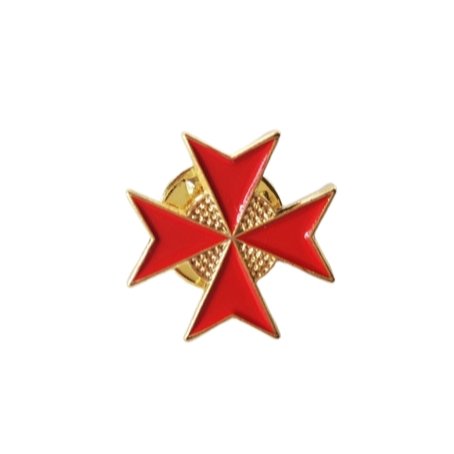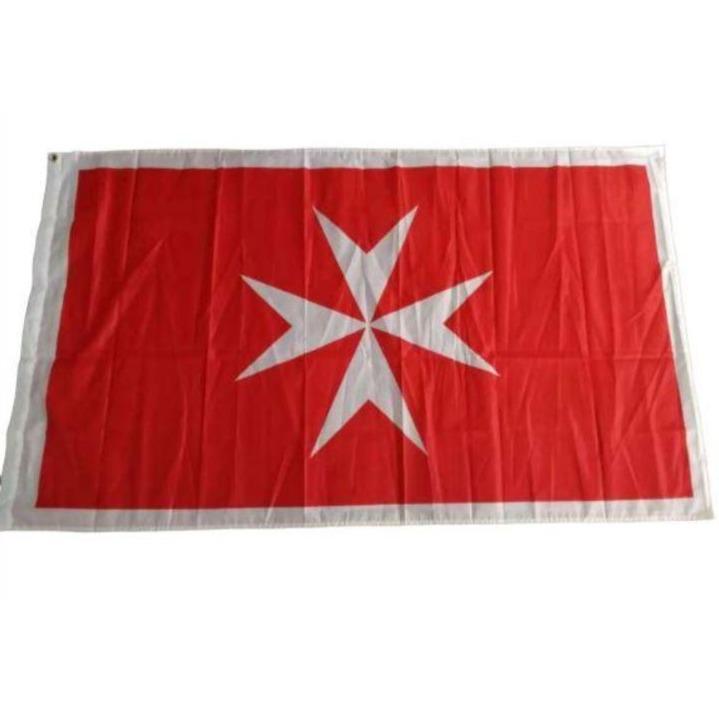Study On the Maltese Cross: Origin and Meaning
Today's topic centers on one of the most popular symbols when it comes to chivalry.
Yes, we will examine together in detail the meaning of the Maltese cross, its history and its origins as well as its various uses which have been made of it yesterday and today.
Contents :
What is the symbol of the Maltese cross?
History and origin of the Maltese cross
The Maltese Cross: lucky symbol for firefighters
The meaning of the Maltese cross
The arrival of this Catholic cross on the island of Malta

What is the symbol of the Maltese cross?
We are talking here about an ancient symbol that is most often associated with the Knights of the Order of Malta (also known as the Knights Hospitaller, or Knights of St. John).
(You can find an example of what a decoration of this order could be here. )
It is precisely this religious military order which governed the Maltese islands between 1530 and 1798.
Since then, this Catholic cross design has been widely associated with Malta. For example, we can find it as the logo of the national airline Air Malta, or as a lucky cross on their coins.
From a purely aesthetic point of view, this cross is made up of four arrowheads whose ends meet at a point.
These four shapes, when put together, form a sort of eight-pointed flower.
Its shape is therefore perfectly symmetrical, from a vertical as well as a horizontal point of view.
The Maltese cross symbol can further be considered a more sophisticated version of the famous Greek cross, a model of a Christian cross with four branches of equal length.
In terms of its colors, it is generally represented in black and white, or in red and white.
Thus the flag of the Maltese Cross shows it drawn in red on a white background.

History and origin of the Maltese cross
Although the use of the Maltese cross was popularized in the 16th century by the order of Knights Hospitaller, there are records of similar crosses dating back to the early 11th century.
Its roots apparently lie in the crosses of the Templars, itself derived from the flag of the Republic of Amalfi (a merchant state located on the southwest coast of Italy).
From its creation, this lucky cross was therefore associated with Christian warriors and knights.
Although the Christian cross of the Knights Templar and that of Malta are different, they have a past, and therefore a meaning, in common.
According to some theologians and Crusade scholars, the origin of the Maltese Cross could more accurately be traced to a group of monks who once served in a hospice built to help travelers who came to visit the Holy Land.
Over time, these monks increasingly began to aid passing pilgrims and provide armed escorts to those traveling through non-Christian territories.
Soon these men, known as the "Brothers of Saint John" saw their organization evolve into a military order, calling themselves the " Knights of Saint John ", or Knights Hospitaller.
We can suspect it, but yes, they notably had a flag with a Maltese cross such as this one as a banner.
You should also know that these knights had another particularity: on the battlefield, they were repeatedly forced to fight fire... literally.

The Maltese Cross: lucky symbol for firefighters
The enemy of the Christians at the time, the Muslims and Saracens, had in fact created a kind of bomb filled with an flammable mixture called naphthas.
As a result, the knights soon found themselves struggling to put out the fires that broke out on the battlefields.
Some had to risk their lives to save their comrades trapped in the flames.
Fighting this type of combat technique actually presented a major problem for the knights: in the dense smoke, it was sometimes difficult to tell an enemy fighter from an ally.
To resolve this, the Knights of the Order of Saint John had the idea of decorating all their armor with the same Christian lucky symbol.
No need to draw a picture, you must know which one we are talking about.
Groups of archers also often placed themselves under a flag with the Maltese Cross to avoid suffering a cavalry charge from their own companions.
In addition to helping them find their way on the battlefield, this Catholic cross also constantly reminded them of the noble cause for which they were fighting.
This therefore explains the origin of the Maltese cross as a symbol of the courage shown by firefighters who risk their lives at the risk of flames.

The meaning of the Maltese cross
Officially adopted by the Knights Hospitaller of Saint-Jean in 1126, it therefore owes its style to the models of crosses used during the Crusades.
Thus, like all the Christian lucky charms that we have already talked about, this one is marked by strong symbolism, and moral values which are often intended to be exemplary.
1st meaning of the Maltese cross: of Catholic nations
Some believe it may refer to the eight medieval nations whose nobles made up the famous Order of Saint John:
- Italy
- Bavaria
- Provence
- Castile and Portugal
- England (with Scotland and Ireland)
- France
- Auvergne
- Aragon
- Castile and Portugal
- England (with Scotland and Ireland)
2nd meaning of the Maltese cross: chivalrous values
The four arms of this Catholic cross would, according to this theory, represent the four cardinal values of chivalry, namely prudence, justice, courage and temperance.
As for the total of eight points formed by its points, specialists most often believe that they symbolize the eight obligations or aspirations of the Christian knight.
These obligations are as follows:
- Live your life in truth
- Be merciful
- Repent for your sins
- Show humility
- Love justice
- Have faith
- Knowing how to be sincere and without reservation
- Being able to endure persecution
In reality, this is not surprising. You can probably better understand why by looking at the Christian cross as a whole.
3rd meaning of the Maltese cross: the qualities of the first aid worker
Unlike others of the same type, the Order of Saint John did not stop functioning with the fall of chivalry in Europe.
It was in fact reconverted into what we know today as the “Sovereign Military Order of Malta ”, an international medical and humanitarian aid organization.
For modern first responders serving in the Order of St. John, the eight corners of the cross represent the qualities they must demonstrate to best help others. They must in fact be able to be:
- Observer (“so that he can note the causes and signs of injury”)
- Tactician (“so that he can, without asking rash questions, learn the patient's symptoms and history, and ensure his confidence”)
- Resourceful ("so that he may make the best use of whatever is at hand to prevent further damage, and to aid Nature's efforts to repair the harm already done")
- Clear (“so that it gives clear instructions to the patient or passers-by on how best to help them”)
- Perseverant (“so that he continues his efforts, even without success at first.”)
- Discriminating (“so that he can decide which of several injuries most requires treatment”)
- Skillful (“so that he can handle a patient without causing unnecessary pain and use devices efficiently and cleanly”)
- Sympathetic (“so that he can bring real comfort and encouragement to suffering”)

The arrival of this Catholic cross on the island of Malta
The very strong link that this symbol has with the island dates from 1530, when the Knights of Saint-Jean settled there for the first time.
By putting their stamp everywhere, they probably did not yet know that they would forever mark the history of this stone lost in the middle of the Mediterranean.
Between architectural prowess and patronage of the arts, this religious military order truly allowed this symbol to achieve continental fame.
At the height of its glory, our lucky cross was found on the coats of arms of cities, in palaces, hospitals, entrances to towers and towers, on fortifications but also on coins, cannons, churches, paintings and frescoes, furniture, silverware and jewelry… In short, the Maltese cross was everywhere!
Even today, Valletta (the capital of Malta) is home to the largest concentration of representations of this symbol in the world.
The palaces and churches built during the long domination of the knights, as well as the numerous treasures that they house today, have indeed been forever marked by this representation of the religious and military power of the former masters of the island..
Thus, the meaning of the Maltese Cross has been associated with the embodiment of one of the most glorious historical periods of chivalry.

Modern uses of the Maltese cross
Needless to say this Catholic cross is still a dominant symbol on the island of Malta.
As we told you just before, you can find this lucky cross almost everywhere.
If you are lucky enough to visit the island of Malta, you will see this type of Christian cross incorporated into the architecture and masonry works of various houses.
Football, rugby, basketball: almost all Maltese sports teams also wear it with pride.
In addition, it is interesting to note that the current flag of this state is indeed inspired by the Maltese cross flag and the order of chivalry which preceded the current state.
We have also seen it: the Sovereign Military Order of Malta also continues to use it as an emblem today.
It is also interesting to see that our cross is used by many fire fighters around the world.
Indeed, many are ready to recognize the heroism and bravery demonstrated by those who once fought the flames in the midst of the horrors of war.
Thus, this cross has become a Christian lucky symbol linked to courage, strength and determination in several countries around the world.
Whether it is made of gold, stainless steel, crystal or plastic, its message will always be one of bravery and courage. (Let's face it, none of us would fall for a model made of diamonds and precious stones!)

Conclusion
It is clear that the origin of the Maltese Cross is most often associated with the Knights of the Order of Hospitallers, as well as with the island itself.
Many Maltese houses still incorporate the cross into their masonry.
A visit to any souvenir or gift shop will also reveal a wide range of local crafts using it.
In addition to t-shirts and key rings, you will find it in many lace and exceptional products, such as jewelry, pottery and glassware.
If you are looking for a necklace, pendant or bracelet, you will find one representing the Maltese cross. For a ring or earrings, it won't be too difficult either.
Despite its very current use, the meaning of the Maltese cross has evolved throughout its history and additional meanings have been added.
In the end, this Christian lucky charm is thus, still today, the symbol of the valiant knights who wore it for the first time hundreds of years ago in distant lands, where everything was unknown to them except love. and the glory of Christ.
Lucky charms featured in this article

Maltese Cross Badge
See more
Maltese Cross Flag
See more
